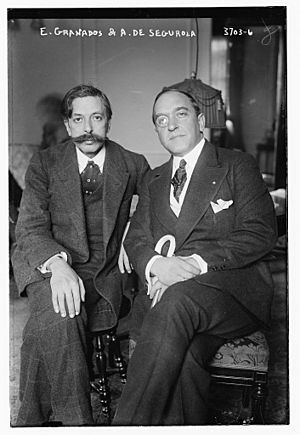Enrique Granados facts for kids
Enrique Granados (born July 27, 1867 – died March 24, 1916) was a famous Spanish composer and pianist. He was born in Lleida, Spain. Granados wrote many beautiful pieces of classical music. Some of his most famous works are Goyescas, the Spanish Dances, and the opera María del Carmen.
Life

Enrique Granados was born to Calixto José de la Trinidad Granados y Armenteros and Enriqueta Elvira Campiña de Herrera. His father was a Spanish army captain. As a young man, Enrique studied piano in Barcelona. His teachers included Francisco Jurnet and Joan Baptista Pujol.
In 1887, he traveled to Paris to continue his studies. He couldn't join the famous Paris Conservatoire. However, he took private lessons with Charles-Wilfrid de Bériot, a professor there. Bériot taught Granados to create very refined sounds on the piano. He also helped Granados improve his ability to improvise music on the spot. Another important teacher was Felip Pedrell.
Granados returned to Barcelona in 1889. He became well-known in the late 1890s. His opera María del Carmen was a big success. It even caught the attention of King Alfonso XIII.
In 1903, Granados won a music competition. He submitted his piece called Allegro de concierto. The judges almost all agreed he was the winner. This win made him famous across Spain.
In 1911, Granados introduced his piano suite Goyescas. This became his most famous work. It is a collection of six piano pieces. Each piece was inspired by paintings by the artist Francisco de Goya. Goyescas was so popular that Granados decided to turn it into an opera.
The opera Goyescas was planned to open in Europe in 1914. But World War I started, so the premiere was canceled. It finally opened in New York City on January 28, 1916. The audience loved it. Soon after, Granados was invited to play for President Woodrow Wilson. Before leaving New York, he also made special recordings for "player pianos." These recordings still exist today.
Death
After his performance for President Wilson, Granados missed his ship back to Spain. He took another ship to England instead. From England, he boarded a ferry called the SS Sussex to travel to France.
While crossing the English Channel, the Sussex was attacked. A German U-boat (submarine) torpedoed the ferry. This was part of Germany's wartime policy of sinking ships without warning.
Sadly, Granados and his wife, Amparo, both drowned. They were on the part of the ship that sank. They left behind six children: Eduard, Solita, Enrique, Víctor, Natalia, and Francisco.
Granados's personal papers are kept in places like the National Library of Catalonia.
Music and influence
Granados wrote many different kinds of music. He composed music for the piano, which he loved to play. He also wrote chamber music, which is for small groups of instruments. This included pieces for piano and violin, and a piano quintet (for piano and four other instruments).
He also wrote songs for singers and zarzuelas, which are Spanish musical plays. One of his orchestral pieces was a symphonic poem based on Dante's Divine Comedy. Many of his piano pieces have been changed to be played on the classical guitar.
Granados's music can be grouped into three main styles:
- Romantic Style: This includes pieces like Escenas Románticas. These works have a dreamy, emotional feel.
- Spanish Nationalist Style: This style shows off Spanish culture. Examples are his Danzas Españolas (Spanish Dances). He also wrote pieces based on popular Spanish songs.
- Goya (Goyesca) Period: This is his most famous style. It includes the Goyescas piano suite and opera. These works were inspired by the paintings of Francisco Goya.
Granados had a big impact on other famous Spanish composers. These included Manuel de Falla and Pablo Casals. He also taught other musicians, like composer Rosa García Ascot.
Some important works
- 12 danzas españolas (1890) for piano. These are twelve Spanish dances.
- María del Carmen (1898), an opera.
- Allegro de concierto (1904), a piano piece he won a competition with.
- Escenas románticas (1903) for piano. This means "Romantic Scenes."
- Dante (1908), a symphonic poem. This is an orchestral piece that tells a story.
- Tonadillas al estilo antiguo, H136 (1910) for voice and piano. These are songs in an old Spanish style.
- Canciones españolas for voice and piano. These are Spanish songs.
- Cançons catalanas for voice and piano. These are Catalan songs.
- Goyescas (1911), a piano suite. This is his most famous work, inspired by Goya's paintings.
- Bocetos (1912). This means "Sketches."
- Colección de canciones amatorias (1915) for voice and piano. This is a collection of love songs.
- Goyescas, an opera (1916).
- 6 Estudios expresivos (Six Expressive Studies).
- 6 Piezas sobre cantos populares españoles (Six Pieces based on popular Spanish songs).
- Madrigal, for cello and piano.
- 8 Valses Poéticos, for piano (Eight Poetic Waltzes).
- Trío, for piano, violin, and cello.
- "Military March", for piano.
Images for kids
See also
 In Spanish: Enrique Granados para niños
In Spanish: Enrique Granados para niños


